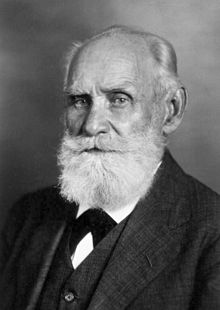Task 3: Classical conditioning
What is classical conditioning?
 Ivan Pavlov
Ivan Pavlov
Classical conditioning (also Pavlovian conditioning or respondent conditioning) is a form of learning in which one stimulus, the conditioned stimulus or CS, comes to signal the occurrence of a second stimulus, the unconditioned stimulus or US. The US is usually a biologically significant stimulus such as food or pain that elicits a response from the start; this is called the unconditioned response or UR. The CS usually produces no particular response at first, but after conditioning it elicits the conditioned response or CR. Classical conditioning differs from operant or instrumental conditioning, in which behavior emitted by the organism is strengthened or weakened by its consequences (e.g. reward or punishment).[1] Conditioning is usually done by pairing the two stimuli, as in Pavlov’s classic experiments.[2] Pavlov presented dogs with a ringing bell (CS) followed by food (US). The food (US) elicited salivation (UR), and after repeated bell-food pairings the bell also caused the dogs to salivate (CR)...
See the complete article here:
http://en.wikipedia.org/wiki/Classical_conditioning
Case study ' the little Albert experiment "
The Little Albert experiment was a case study showing empirical evidence of classical conditioning in humans. This study was also an example of stimulus generalization. It was conducted in 1920 by John B. Watson along with his assistant Rosalie Rayner. The study was done at Johns Hopkins University...
... by present-day[vague] standards, Watson's experiment was unethical for numerous reasons. It is now measured immoral to evoke reactions of fear in humans under laboratory circumstances, except if the participant has given an informed approval to being purposely horrified as part of the experiment. Experiments should not cause the human participants to suffer unnecessary distress or to be in any way physically harmed. The welfare of the human participants must always be the paramount consideration in any form of research, and this is especially true with specially protected groups such as children... John B. Watson, after observing children in the field, was interested in finding support for his notion that the reaction of children, whenever they heard loud noises, was prompted by fear. Furthermore, he reasoned that this fear was innate or due to an unconditioned response. He felt that following the principles of classical conditioning, he could condition a child to fear another distinctive stimulus which normally would not be feared by a child...
See the complete article here:
http://en.wikipedia.org/wiki/Little_Albert_experiment
When you have some spare time you should work through the 'Classical conditioning module at http://alison.com/courses/Diploma-in-Psychology
 Ivan Pavlov
Ivan PavlovClassical conditioning (also Pavlovian conditioning or respondent conditioning) is a form of learning in which one stimulus, the conditioned stimulus or CS, comes to signal the occurrence of a second stimulus, the unconditioned stimulus or US. The US is usually a biologically significant stimulus such as food or pain that elicits a response from the start; this is called the unconditioned response or UR. The CS usually produces no particular response at first, but after conditioning it elicits the conditioned response or CR. Classical conditioning differs from operant or instrumental conditioning, in which behavior emitted by the organism is strengthened or weakened by its consequences (e.g. reward or punishment).[1] Conditioning is usually done by pairing the two stimuli, as in Pavlov’s classic experiments.[2] Pavlov presented dogs with a ringing bell (CS) followed by food (US). The food (US) elicited salivation (UR), and after repeated bell-food pairings the bell also caused the dogs to salivate (CR)...
See the complete article here:
http://en.wikipedia.org/wiki/Classical_conditioning
Case study ' the little Albert experiment "
The Little Albert experiment was a case study showing empirical evidence of classical conditioning in humans. This study was also an example of stimulus generalization. It was conducted in 1920 by John B. Watson along with his assistant Rosalie Rayner. The study was done at Johns Hopkins University...
... by present-day[vague] standards, Watson's experiment was unethical for numerous reasons. It is now measured immoral to evoke reactions of fear in humans under laboratory circumstances, except if the participant has given an informed approval to being purposely horrified as part of the experiment. Experiments should not cause the human participants to suffer unnecessary distress or to be in any way physically harmed. The welfare of the human participants must always be the paramount consideration in any form of research, and this is especially true with specially protected groups such as children... John B. Watson, after observing children in the field, was interested in finding support for his notion that the reaction of children, whenever they heard loud noises, was prompted by fear. Furthermore, he reasoned that this fear was innate or due to an unconditioned response. He felt that following the principles of classical conditioning, he could condition a child to fear another distinctive stimulus which normally would not be feared by a child...
See the complete article here:
http://en.wikipedia.org/wiki/Little_Albert_experiment
When you have some spare time you should work through the 'Classical conditioning module at http://alison.com/courses/Diploma-in-Psychology

